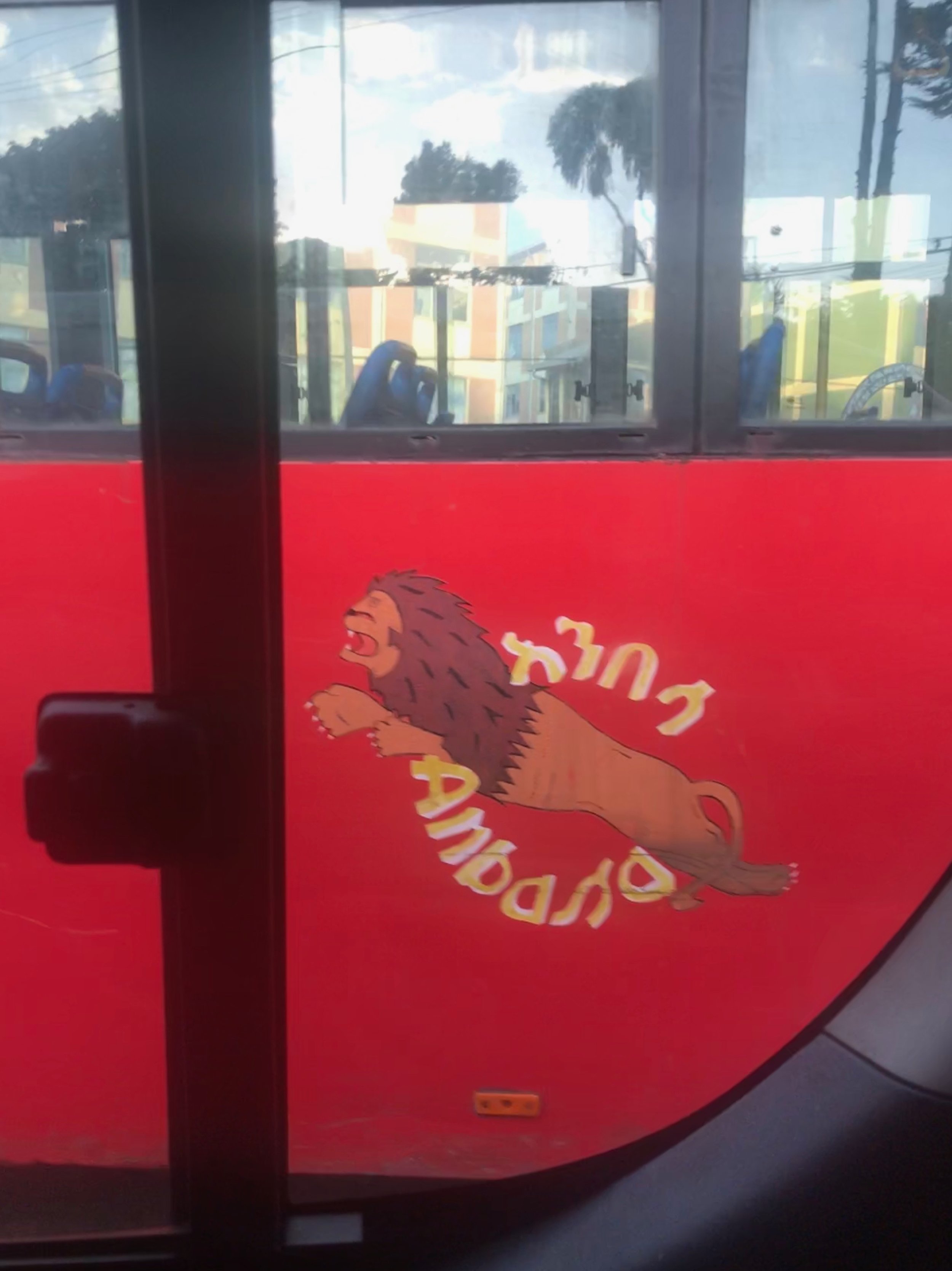It is a short 4.5 hour flight from Tel Aviv to Ethiopia, our first stop on the 2018 birthday tour for A. He decided he’d like to spend his birthday with the Silverback Gorillas in Rwanda, with a hop over to Kenya and then into Zanzibar.
The flight, like many that leave from Tel Aviv, was at 1am, which meant we would arrive at 6:45 in the morning with a 7 hour layover in Addis Ababa. At the suggestion of Carol at Duffle & Compass, we decided to do a day tour to see a little bit of what Ethiopia had to offer. Ethiopia is an ancient biblical kingdom in Africa. It was a Monarchy until 1974 when the King was overthrown. It is the only country in Africa that wasn’t colonized. The Italians tried to take over in 1895, but the Ethiopian army defeated them and maintained their independence.
We were met at the striking and modern airport by Yonas, our guide. Our first stop was a drive up to Mount Entoto. It was just 6:45 am, so the traffic hadn’t had a chance to build. This was nice because there doesn’t seem to be any actual delineation between the north and southbound lanes of traffic. Our car wove back and forth between lanes into and out of oncoming traffic. “It doesn’t matter” Yonas said, “as long as we manage to move forward.” There are hundreds of people on either side of the road catching buses painted with lions, blue and white mini-van ‘taxis’ filled to capacity, and school children in uniform walking and running up and down the hills. No wonder Ethiopia is known for its runners. They get twice daily practice, probably going long distances.
Mount Entoto is the tallest peak in Ethiopia at 3,200 meters - twice the altitude of Denver. On the way we left the construction boom and its dust in the city beneath us and were surrounded by a forest dense with eucalyptus trees. We walked around the church of St. Mary and Menelik Palace. St. Mary is a Christian church, but there are a mix of both Christians and Muslims living together here peacefully. Most women wear head-scarves in Addis, but you can tell the difference because Christian women wear white scarves and Muslim women wear other colors. Ethiopia was also home to a large jewish community until 1991 when an Israeli military operation sent 35 planes in 36 hours to transport over 14,000 Ethiopian Jews to Israel because of a threatening political situation. There were a few white scarf worshippers outside of the church near a large framed image of a Saint. Besides that and a weathervane-like cross mounted on its roof, you would never know this building was a church. It looked more like a french colonial building transported from New Orleans then decorated with flags and banners in the colors of the Ethiopian flag.
As someone who worked n Graphics and Typography, I love the rough and tumble type on this sign for a National Monument.
Behind the Church is the original Palace and guest house, simple structures made from mud, straw, and brick. It was amazing to me that these buildings dating back to 1877 are still able to house tourists. The Palace ceilings stood an ambitious 10-12 ft high, and its rooms were mainly used for royal gatherings. Across the broken floorboards we could see the store rooms where they traditionally kept dried beef flanks hanging from horns of cattle recycled as ‘hooks’, and barrels of honey wine - a typical liquor of that time. It was interesting to imagine guests could serve themselves a glass of honey wine from a barrel, then grabbing a knife to slice off a piece of beef jerky while watching the ceremonies. There are many graves and tombs sprinkled around the grounds of the church so that the deceased could be buried closer to god.
Horns as Hooks
We took a stroll down the mountain to a view point overlooking the city. We joined the parade of kids coming out of their homes and onto the road beginning their walk to school. I remember when I was a kid and didn’t clean my plate at dinner, I was always reminded that children in Ethiopia were starving. When I imagined it, Ethiopia was a dusty impoverished desert. It is always an eye opening experience to travel and have your pre-conceived notions of countries shattered when you encounter the reality of the place. The view of the sprawling city of Addis was surrounded in every direction by green mountains. To me it looked a little like the Hollywood Hills, smog and all, with a lot more forest. I think they could use a copycat sign that says A D D I S A B A B A made out of all-cap white letters.
Since it was still too early to visit the National Museum, Yonas took us back into town to Tomoca Coffee House, the oldest in Ethiopia. It was crazy old-school-cool with red lacquered coffee grinders, bean weighing scales, and hand-painted vintage maps of Africa. The sign behind the coffee pick up area was a painting of another lion accompanied by a famous Balzac quote “When we drink coffee, ideas march in like the army.” Apparently the Lion is a symbol of bravery and resistance for Ethiopians and harkens back to the Monarchy and its presence on the Ethiopian Flag until 1975.
The place was packed with older men who have probably sipped their daily coffee here for decades while reading the morning paper. There was even a Addis hipster or two wearing pork pie hats and vests. The thing that was most striking is that A and I were the only white people, and I was the only woman. But I didn’t feel uncomfortable or unwelcome at all.
By this time it was almost 3 hours since we de-planed and because Tomoca is so small and old-school, there are no toilets. If there were toilets - judging by the clientele, there would probably not be a Ladies room. Yonas assured us we could use the toilets at the National Museum which was a relief. When we arrived we were shown the toilets. The women’s room had three stalls - none with doors. Across from the toilets was a sink with a mirror above it, flanked by two sink height large yellow barrels filled with water. The situation was a little confusing, it felt like the barrels were an integral part of using the toliet or the sink, but there was no signage explaining what to do. I almost walked out, hoping I could make it back to the airport, but that would be another 1.5 hours in the future. Luckily I had a packet of tissue in my purse since I also discovered that there was no toilet paper. There was also no way to flush the toilet. In horror (not so bad - I only peed), I put a dollar on the sink as an apology and left. I can't believe I didn't take a photo of this set up! Then again, I was in a hurry to disappear....
Before we went to visit the most famous attraction at the Museum - Lucy - one of the oldest Hominids on the planet, Yonas wanted to show us the turtles that lived on the grounds. They were both about 130 years old and it was mesmerizing to watch these prehistoric creatures walk and eat. It was a good animal lead-in to our upcoming Gorilla Trek, Elephant Rescue visit, and Giraffe feeding and possible swimming with Dolphins.
130 year old Turtle is also a silverback!
In the garden of the National Museum was a curious statue of Alexandre Pushkin, the founder of modern Russian literature. According to legend, Pushkin’s great grand father was an Ethiopian Prince, a descendant of Menelik I, who was the son of Israels’ King Solomon and the Ethiopian Makeda, better known as the Queen of Sheba. Thats the short version. Every religion has a different take on the story of Soloman and Sheba - I say story because its impossible after reading all the versions to understand what is real, or in todays vernacular, ’fake news.’ But after reading all these versions, what you do understand is that every religion recognizes the significance of Ethiopia’s religious history.
The national Museum of Ethiopia is just 4 floors and houses artifacts ranging from Ethiopian ceremonial costumes, traditional and contemporary art, weapons and agricultural tools, and cultural artifacts like jewelry, furniture, baskets and the tools that made them. In the basement is the archeology section with hand tools, fossils and the remaining bones of many Hominids. The first and most famous find was in 1974 when 40% of the bones of 'Lucy’ were discovered. She is approximately 3.2 million years old. The archeologists named her Lucy because the Beatles “Lucy in the Sky with Diamonds” was playing in the camp where she was discovered. In the Ethiopian language Amharic, they call her Dinkinesh which means ‘you are marvelous.’
Hard to believe these bones are 3.2 million years old!
We drove back through the construction to Addis so Yonas could deliver us back to the airport for our flight to Rwanda. I wonder if the construction boom will carry on up the mountain and include any transportation projects that will create aerial tramways, funiculars or cableways. I worry that this will impact the reputation of Ethiopia as a nation of runners. I just read that in the Dubai Marathon on January 25th, 2018, 10 of the 10 top finishing times for men were all Ethiopians. And the women? 9 out of 10!
I say Dinkinesh to all the Men and Women of the Marathon - Dinkinesh! “You are Marvelous!”














